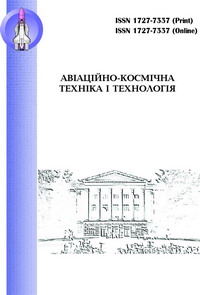Simulating multi-particle deposition based on cel method: studing the effects of particle and substrate temperature on deposition
Abstract
The subject matter of this study is to use numerical simulation methods to study the influence of the temperature of particles and substrates on the post-deposition coating during the multi-particle deposition process of cold spray. The goal is to study the temperature of Al6061 particles and the temperature of the substrate, which are factors that have a greater impact on the deposited coating, and to observe the shape of the coating and the temperature distribution of the cross-section of the substrate after deposition. The tasks to be solved are as follows: use Python scripts to model multi-particles, generate and randomly assign positions according to particle size distribution in the Euler domain, and establish a cold spray multi-particle collision model to simulate the process of cold spray deposition. The following methods were used: The influence of temperature and substrate temperature on the deposited coating was studied through a single variable method; the Coupled Eulerian Lagrangian (CEL) method was used to simulate the collision process of cold-sprayed Al6061 multi-particles. The following results were obtained: changing the temperature of Al6061 particles has a more obvious control effect on the porosity of the deposited coating; after particles of different temperatures impact the constant-temperature substrate, the high-temperature area on the surface of the substrate is mainly located at the junction of pits; after the particle temperature reaches 650K, the coating changes after deposition are no longer significant, indicating an optimal temperature range for Al6061 particle deposition; increasing the temperature of the substrate can increase the depth of particle deposition on the substrate; at the same time, it serves as a reference basis for further using the CEL method to predict the porosity of the Al6061 coating. Conclusions. The scientific novelty of the results obtained is as follows: 1) powder preheating can effectively reduce the porosity of Al6061 coating; 2) the CEL method has good robustness and is used to simulate cold spray multi-particle deposition to monitor the porosity of the coating, which cannot be achieved by the SPH and ALE methods. Предметом статті є використання методів чисельного моделювання для вивчення впливу температури частинок і підкладок на покриття після осадження під час процесу осадження багатьох частинок холодним розпиленням. Мета полягає в тому, щоб вивчити температуру частинок Al6061 і температуру підкладки, який фактор має більший вплив на нанесене покриття, а також спостерігати за формою покриття та розподілом температури в поперечному перерізі підкладки після нанесення. Завдання, які необхідно вирішити: використовувати сценарії Python для моделювання багатьох частинок, генерувати та випадково призначати позиції відповідно до розподілу частинок за розмірами в області Ейлера; створити модель зіткнення багатьох частинок холодного розпилення для імітації процесу осадження холодного розпилення. Використані методи: Вплив температури та температури підкладки на нанесене покриття вивчався за допомогою методу однієї змінної; метод CEL був використаний для моделювання процесу зіткнення холодно розпилених багато частинок Al6061. Було отримано наступні результати: зміна температури частинок Al6061 має більш очевидний контрольний вплив на пористість нанесеного покриття; після того, як частинки з різною температурою впливають на підкладку з постійною температурою, високотемпературна область на поверхні підкладки в основному розташована на стику ямок; Коли після того, як температура частинок досягне 650 К, зміни покриття після осадження більше не є значними, що вказує на те, що існує оптимальний діапазон температур для осадження частинок Al6061; підвищення температури підкладки може збільшити глибину осадження частинок на підкладці; Водночас він служить еталонною базою для подальшого використання методу CEL для прогнозування пористості покриття Al6061. Висновки. Наукова новизна отриманих результатів полягає в наступному: 1) попереднє нагрівання порошку може ефективно зменшити пористість покриття Al6061; 2) метод CEL має добру надійність і використовується для імітації осадження багатьох частинок холодним розпиленням для моніторингу пористості покриття, чого неможливо досягти методами SPH і ALE.

